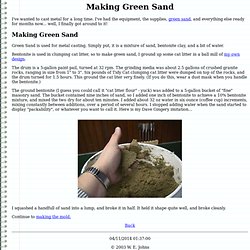

Furnace Tips. Richard Furrer Blacksmith. India: Shiva Nataraja (Lord of the Dance) Armstead Snow Motors. Shed stuff, Foundry stuff, Lathe stuff. Site Started May 2001::Updated 29th December 2011 (Gingery Shaper section) Most photo's on these pages are of sufficient quality that you may enlarge them somewhat to see them more clearly when you want.

For those who don't know; on Mozilla Firefox browser you can just press and hold down the Ctrl key then press the + key, each time you press the + key the whole PAGE zooms larger, press Ctrl and - keys to go back smaller. I think this is the same for MS Internet explorer. Also for Firefox if you just want to enlarge a particular photo then right click on the photo, choose "View Image" then use the Ctrl and + keys, more than once if you wish to enlarge the photo and Ctrl and - key to go back smaller, press the back arrow button to return to the page.
Other browsers most likely will have similar abilities some how or other. Do not take any information on these pages as a recommendation for you to do the same or similar. Small pics. are links to larger pics. Making Green Sand. I've wanted to cast metal for a long time.

I've had the equipment, the supplies, green sand, and everything else ready for months now... well, I finally got around to it! Green Sand is used for metal casting. Simply put, it is a mixture of sand, bentonite clay, and a bit of water. Bentonite is used in clumping cat litter, so to make green sand, I ground up some cat litter in a ball mill of my own design. The drum is a 5-gallon paint pail, turned at 32 rpm. The ground bentonite (I guess you could call it "cat litter flour" - yuck) was added to a 5-gallon bucket of "fine" masonry sand. I squashed a handfull of sand into a lump, and broke it in half. UMHA AOIS (BRONZE AGE) - Experimental bronze casting project. Lost Wax, Found Bronze: The Art and Technique of Lost Wax Bronze Casting. Lost Wax Casting. Homemade steel/iron crucibles. Coffee Can Foundry MkII.
Whats a CCF, and what happend to the MkI version? Introduction In the fall of 1998 I built my Coffee Can Foundry. It worked much better than expected and served as a proof of concept test. Ironworking. Foundry. This past Monday I finally got started on my foundry project! I've been collecting material for some time so I was ready to roll once Maker Faire '09 concluded. The goal is to built a foundry furnace capable of melting brass and perhape iron, if I'm lucky. I'm using Dave Gingery's Building a Gas Fired Crucible Furnace as a general guide, but I intend to fuel my furnace with gasoline and waste oil (both veggie and motor) rather than propane (that would be far too easy!).
The main reason for the use of this dangerous fuel is to gain experience with petrol burners for application in a future steam car project. More after the cut . . . Casting Aluminum At Home, Part 1. I've been wanting to try my hand at casting aluminum motorcycle parts for quite some time now, and being that my pile of scrap aluminum now fills several trash cans I thought it time I start building the foundry or sell off the aluminum. Remember: I'm learning as I go. Coffee Can Foundry. My fun, simple, and best of all, CHEAP introduction to aluminum casting. Introduction During the summer of '98, in the newsgroup rec.crafts.metalworking, I saw mention of the miniature foundry project detailed at this page appears to have disappeared) Shortly thereafter (about 7 seconds after reading the web page) I started thinking about potential improvements/modifications.
Melting metal in a home foundry, backyard metalcasting, metal casting. Bronze Art Casting Process. History of the Lost Wax method There is no accurate record of when the lost wax method of casting was first utilized. It is believed the earliest users of the lost wax method began with a clay core roughly the shape of the subject to be sculpted. This core was covered with wax, and then sculpted to the finished form. Once the wax hardened it was covered with clay. The object was baked, hardening the clay and melting the wax. Other names for the process include "lost mould," which recognizes that other materials besides wax can be used, including but not limited to: tallow, resin, tar, and textile; and "waste wax process" or "waste mould casting", because the mould is destroyed to unveil the cast item.
How to slush cast. Products used in this How To: To slush cast is to pour a fraction of the amount of resin into your mold (typically of a bigger piece that has a lot of volume) and coat the sides with it by rotating the mold while the resin cures. Once the sides are coated, you can back fill the piece or leave it to be hollow. To start, pick an original that you would like to slush cast.